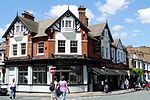Greenwich Hospital, London

Greenwich Hospital was a permanent home for retired sailors of the Royal Navy, which operated from 1692 to 1869. Its buildings, in Greenwich, London, were later used by the Royal Naval College, Greenwich and the University of Greenwich, and are now known as the Old Royal Naval College. The word "hospital" was used in its original sense of a place providing hospitality for those in need of it, and did not refer to medical care, although the buildings included an infirmary which, after Greenwich Hospital closed, operated as Dreadnought Seaman's Hospital until 1986. The foundation which operated the hospital still exists, for the benefit of former Royal Navy personnel and their dependants. It now provides sheltered housing on other sites.
Excerpt from the Wikipedia article Greenwich Hospital, London (License: CC BY-SA 3.0, Authors, Images).Greenwich Hospital, London
King William Walk, London East Greenwich (Royal Borough of Greenwich)
Geographical coordinates (GPS) Address Website Nearby Places Show on map
Geographical coordinates (GPS)
| Latitude | Longitude |
|---|---|
| N 51.482222222222 ° | E -0.0066666666666667 ° |
Address
Old Royal Naval College
King William Walk
SE10 9HX London, East Greenwich (Royal Borough of Greenwich)
England, United Kingdom
Open on Google Maps








